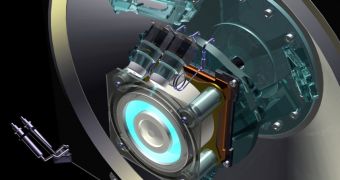The ion engine is the best electric propulsion system available for spacecraft so far. It's the engine which can produce the best electric power to thrust conversion rate. It also has the highest specific impulse, of about 3000secs (around 30,000 km/s or 18,600 mph) and the longest operational lifetime. It surpasses every conventional chemical or nuclear engine available. The principles of Ion thrusters go back to the concepts developed by the German/Austrian physicist Hermann Oberth and were published in his famous 1929 work "Die Rakete zu den Planetenr?umen" (The rocket to planetary space).
The first ion thrusters, known as Kaufman-type ion thrusters, were developed by Harold R. Kaufman, working for NASA in the 1960s, and were based on the Duoplasmatron. They can achieve the fastest trip time yet with the lowest initial mass, thus allowing interplanetary missions at a low cost.
The name ion engine or ion thruster comes from the fact that it uses the ionization of the propellant gas, produced through electron bombardment. First, the engine releases electrons from a cathode by heating it, then the resulting electric charge accelerates the electrons towards the anode and into the discharge chamber. Then, the gas used for propulsion, the most common being Xenon (Xe), is forced into the chamber, which has been previously magnetized to increase the probability of collision between the propellant gas atoms and the electrons.
The electrons that collide with xenon atoms strip off other electrons from these atoms, thus ionizing the atoms, which are now positively charged. Ions are very excited and move around at high speeds, and when a very high voltage is produced by metal grids at the back of the chamber, the electrostatic pull causes the electrons to accelerate through the grid.
The speed at which the ions travel reaches 31.5 km/sec (the speed of sound is only 1.2 km/sec) and then they are focused into an ion beam before finally being exhausted out of the back of the spacecraft. Through a final stage neutralizer, the excessive electrons are also injected into the ion beam, thus preventing the spacecraft from charging to a large negative potential.
For now, the ion drive propulsion system is, despite some disadvantages, very useful for propulsion systems on planetary missions, as it is able to build up to very high velocities, far greater than any other chemical propulsion systems in the world.

 14 DAY TRIAL //
14 DAY TRIAL //